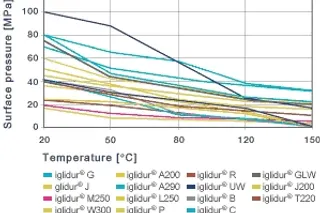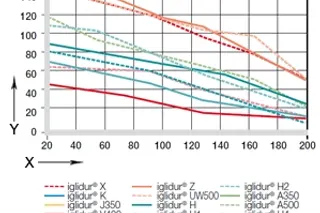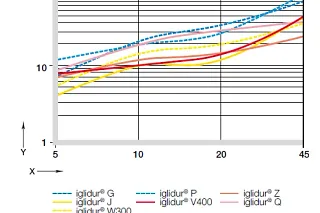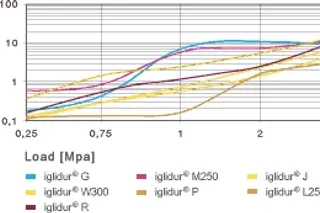Change Language :
iglidur load

X = temperature [°C]
Y= surface pressure [MPa]
Surface pressure
The load of a plain bearing is expressed by the surface pressure (p) in MPa (corresponds to N/mm2). For this purpose, the radial load is distributed over the projected surface of the bearing.
Radial bearing: p = F/ (d1 * b1)
For thrust bearings, the load is calculated accordingly.
Thrus bearing: p = F/(d22 - d12) * π/4
where
F
load in N
d1
Bearing's inner diameter in mm
b1
Bearing length in mm
d2
Outer diameter of the bearing in mm

Maximum recommended surface pressure as a function of temperatureX = temperature [°C]
Y = surface pressure [MPa]
Maximum recommended surface pressure
A characteristic value of the iglidur materials is the maximum recommended surface pressure [p], static at +20°C. The individual iglidur bearings differ greatly on this point. The characteristic value [p] indicates the limit of the load capacity of a plain bearing. The plain bearing can withstand this load continuously without damage. The specified value applies to static operation; only very slow speeds of up to 0.01m/s are permissible with this load. Higher loads are possible if the duration of the load is short. Please call us if you have any questions.

X = load [MPa]
Y = wear [μm/km]
Wear of iglidur plain bearings under medium and high loads
Load and temperature
Diagrams 02 and 03 show the maximum recommended surface pressure of the iglidur plain bearings as a function of temperature.
With increasing temperature, this value decreases continuously. Take advantage of the opportunity presented by the predictability of the iglidur plain bearings to detect such effects in advance, or determine the effective temperatures in the test.

Wear of iglidur plain bearings at low loads
Load and wear
The load of the plain bearing has an effect on the wear of the bearing. The following diagrams show the wear behaviour of the iglidur® bearing materials. It can be easily seen that for each load, there is an optimal plain bearing available. The wear is shown as a wear rate in[μm/km].
Consulting
I look forward to answering your questions
OEM Finland OY+358 207499499Write e-mail
Shipping and consultation
In person:
Monday to Friday from 7 am - 17 pm.
Saturdays from 8 am- 12 pm.
Online:
24h
WhatsApp-Service:
Montag – Freitag: 8 – 16 Uhr